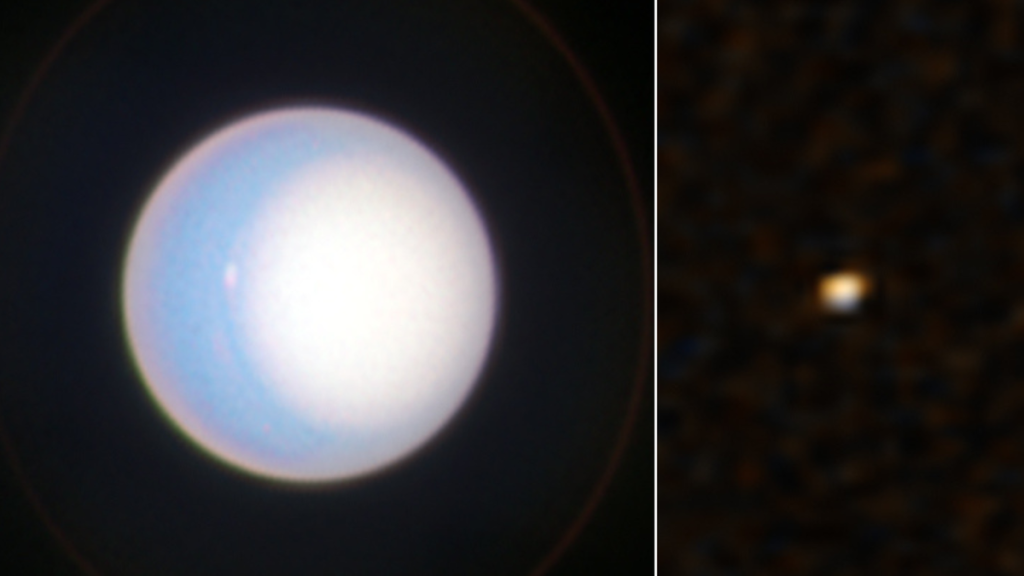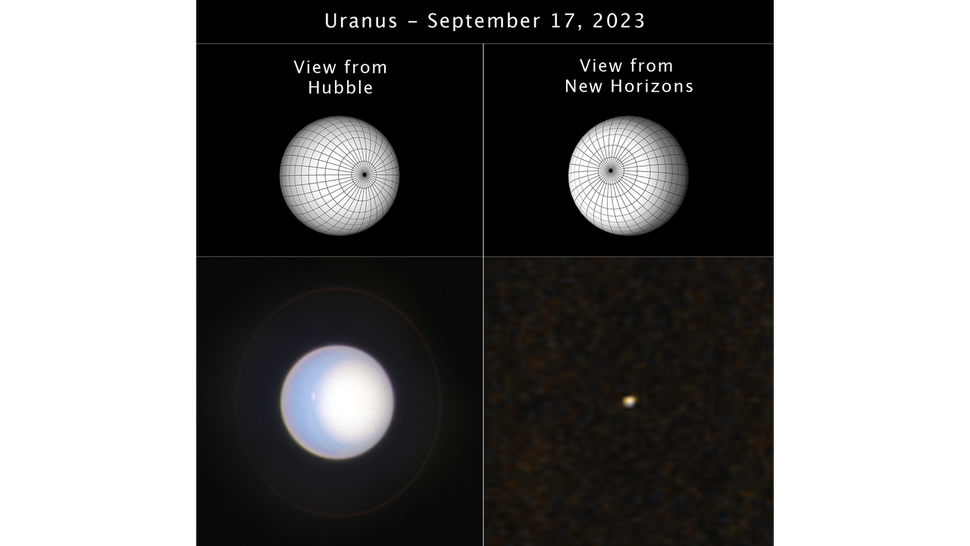
Hubble Telescope and New Horizons Pluto probe team up to image Uranus (Image Credit: Space.com)
Two NASA spacecraft have teamed up to capture direct images of Uranus.
The Hubble Space Telescope and the New Horizons Pluto probe formed a cool tag team to investigate the mysterious seventh planet from the sun.
The views of Uranus, the coldest world in the solar system, captured by the two instruments are vastly different and are taken from different perspectives. Hubble studied the ice giant in high resolution, while New Horizons saw it as a mere smeared “blob.” This actually gives astronomers a new view of the ice giant, with Hubble observing what the Uranian atmosphere is doing while New Horizons looks as well, providing vital added context.
Though astronomers have a wealth of questions about Uranus, it is relatively well-studied compared to exoplanets beyond our solar system. The hope is that this new way of looking at Uranus could unlock a powerful new guide to what astronomers should expect when using future telescopes to image exoplanets directly, something that is notoriously tricky.
“While we expected Uranus to appear differently in each filter of the observations, we found that Uranus was actually dimmer than predicted in the New Horizons data taken from a different viewpoint,” New Horizons science team collaborator Samantha Hasler of the Massachusetts Institute of Technology (MIT) said in a statement.
Related: Some of Uranus’ moons might be able to support life. Here’s what a mission might reveal
Why directly image exoplanets?
Since the discovery of the first exoplanet in the 1990s, astronomers have uncovered over 6,000 of these worlds, with thousands more detected but awaiting confirmation.
Most of these have been detected and studied by the dips in starlight they cause when they cross or “transit” the face of their parent star. Fewer are detected and investigated when they gravitationally “tug” on the star they orbit, causing a tiny “wobble” in its motion. Very few exoplanets have actually been directly imaged.
That’s because even the closest exoplanet to the solar system, Proxima Centauri b, is a whopping four light-years away. That’s about 13,840 times the distance between Earth and Uranus. This means that, even when astronomers do manage to directly image an exoplanet — usually when they are just partially illuminated by their stars — it appears as little more than a tiny speck.
Direct imaging of exoplanets is desirable because it can reveal whether they are capable of supporting life or not. It can also reveal similarities with solar system planets, which could help astronomers better understand how planets form.
That’s where Uranus comes in.

Uranus is a good proxy for exoplanets for several reasons. For example, many known exoplanets are gas giants with compositions similar to that of Uranus. Additionally, New Horizons was able to examine Uranus while the ice giant was around 6.5 billion miles (10.5 billion kilometers) away from the spacecraft, allowing its Multispectral Visible Imaging Camera to capture what is called the ” twilight crescent” of the planet, which is also useful for investigating exoplanets.
While New Horizons was performing its distant observations, Hubble, in low-Earth orbit around our home planet, was only 1.7 billion miles (2.7 billion km) away from Uranus. This meant the long-serving space telescope, which launched in 1990, was able to discern the atmospheric features of the sun-facing “dayside” of Uranus, spotting Uranian clouds and storms.
“Uranus appears as just a small dot on the New Horizons observations, similar to the dots seen of directly imaged exoplanets from observatories like the James Webb Space Telescope (JWST) or ground-based observatories,” Hasler continued. “Hubble provides context for what the atmosphere was doing when it was observed with New Horizons.”
No cloudy days ahead for NASA’s future space telescopes
One of the questions that researchers are keen to answer regarding exoplanets is whether they have clouds similar to those of solar system planets, particularly the gas and ice giants.
In the solar system, the gas giants Jupiter and Saturn and the ice giants Uranus and Neptune have dynamic atmospheres with changing cloud cover. We don’t know if exoplanet gas giants have similar conditions, though.
The team used details of Uranus’ clouds collected using Hubble to verify what the New Horizons spacecraft — launched in 2006 to perform a close flyby of Pluto, which it achieved in 2015 — was seeing. This revealed that brightness did not vary as the planet rotated, indicating to the team that the cloud features of Uranus were not changing as a result of the planet’s rotation.

The New Horizons observations, from an angle differing from that used by Hubble, also demonstrated that when planets are partially lit by their stars, the circumstance used to image exoplanets, they can be dimmer than predicted. It also seems from the observations that light is reflected differently by planetary atmospheres during their partially lit phase.
“These landmark New Horizons studies of Uranus from a vantage point unobservable by any other means add to the mission’s treasure trove of new scientific knowledge and have, like many other datasets obtained in the mission, yielded surprising new insights into the worlds of our solar system,” New Horizons principal investigator Alan Stern, of the Southwest Research Institute, said in the statement.
The team’s research could help to inform studies of exoplanets performed by NASA’s next major space telescope, the Nancy Grace Roman Space Telescope, or just Roman for short. Roman, set to launch in 2027, will use a device called a coronagraph to block out light from the stars that exoplanets orbit to get a better view of these worlds.
Further into the future, NASA’s Habitable World’s Observatory, currently in its initial planning stages, will become the first space telescope specifically designed to hunt for biosignatures around Earth-like rocky planets.
“Studying how known benchmarks like Uranus appear in distant imaging can help us have more robust expectations when preparing for these future missions, and that will be critical to our success,” Hasler concluded.
The team’s results were presented this week at the 56th annual American Astronomical Society Division for Planetary Sciences meeting held in Boise, Idaho, between Oct. 6 and Oct. 10.





